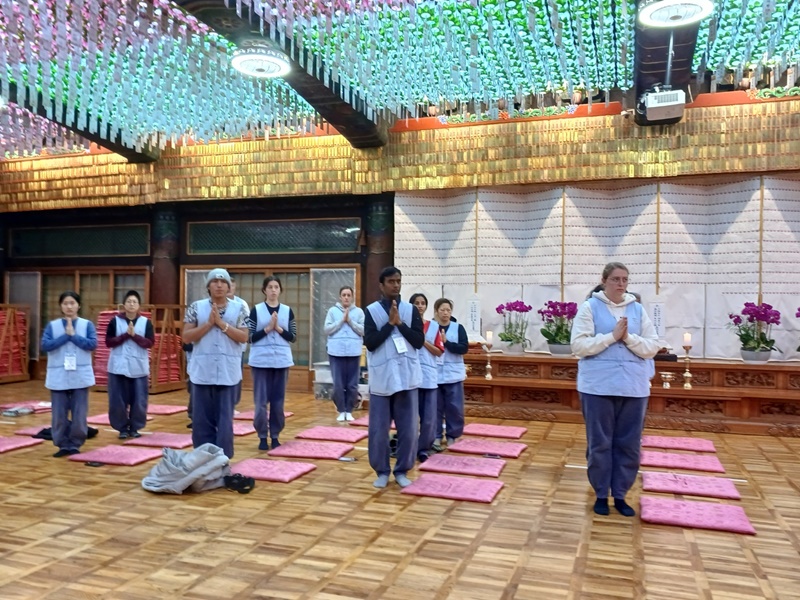
Eighteen foreign nationals from April 18-19 took part in a templestay at Hwagyesa Temple in Seoul's Gangbuk-gu District to experience domestic Buddhist culture. They are shown here on April 19 performing an early morning ritual. (Hwagyesa Temple)
A friend suggested that I do a templestay in Korea. I had visited many temples in the country but never went on a templestay. So with this friend, I applied for one at Hwagyesa Temple near Bukhansan Mountain in Seoul's Gangbuk-gu District.
Gangbuk-gu Office hosted the overnight event from April 18-19 free for 18 foreign participants from countries like the U.S., U.K., France, Canada, Malaysia and Vietnam.
Through the efforts of Ven. Seungsahn, a Buddhist master who traveled the world starting with the U.S. in 1972 to propagate Korean Buddhism, Hwagyesa's status grew as a temple in Korea frequented by foreign visitors.
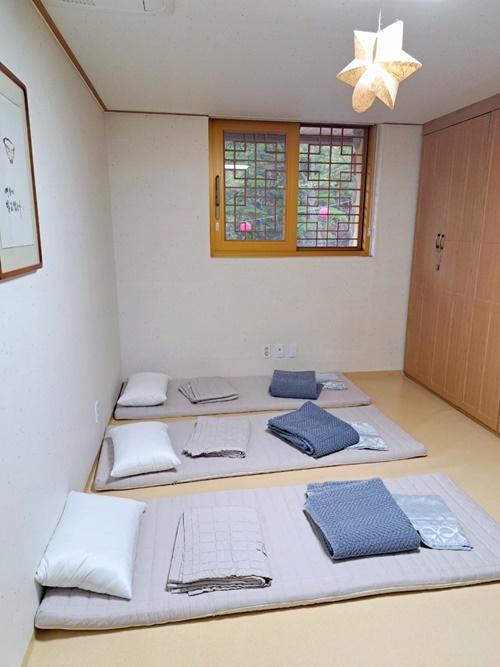
Templestay participants on April 18 arrived at a building of Hwagyesa Temple for the program. They were assigned rooms and received modern versions of daily Hanbok (traditional clothes) to wear. (Laida Landea Ruiz)
I was excited after arriving around 6 p.m. at Hwagyesa. Though located in Seoul, the temple meshes well with the lush forest of Bukhansan Mountain in providing the atmosphere of a mountain temple.
After entering through the main gate, I felt a sense of peace in smelling nature from the trees and grass and fresh air from the mountain and experiencing serenity inside the temple. This was when I left the hustle and bustle of daily life for a temporary rest.
Arriving at the templestay venue of the International Zen Center, the 18 foreign participants including me were assigned rooms of three people each and began our first program. We each received a modern version of daily Hanbok (traditional clothes) to wear during our stay.
Surprisingly, my room was extremely tidy and clean, covering 16.5 square m with a shoe shelf, wardrobe, mattresses, cushions, blankets, bathroom, kettle and porcelain teacup sets.
Just as Koreans wear modern versions of daily Hanbok during temple stays, Vietnamese wear ao lam, or clothing worn at temples. The difference is that in Vietnam, participants have to bring their own clothing.
Korean templestays are also smaller scale and held in all four seasons, whereas those in Vietnam are large with around 100 participants if small and over 3,000 if large and usually last seven or more days during summer.
Orientation began at 7 p.m. We drank tea, ate snacks and received a briefing on our overall schedule. Though small, this templestay was similar to most interactive programs in Korea in that it offered tea and refreshments, something that I found interesting.
We first watched a video on proper temple etiquette and learned 108 bae (prostrations) to Buddha to ward off 108 types of anguish humans experience from the past, present and future.
We also drew simple pictures of mandalas, or geometric configurations of symbols used in Buddhism, and made eco-friendly bags with the designs.
Temple life was similar to that of the military because of strict adherence to a schedule. At 9 p.m., we had to turn off all lights and sleep. I worried about sleeping on the floor instead of a bed, but the 10 cm-wide mattress was soft enough that I comfortably fell asleep.
We woke up the next day at 4:20 a.m. to participate in early morning Buddhist rituals.
The rituals were held at Daejeokgwangjeon (Vairochana or supreme Buddha) Hall, the largest building at the temple. Afterwards, we had breakfast, something I most looked forward to. The simple-but-filling meal contained pumpkin, cabbage and cucumber kimchi, eggplant, japchae (stir-fried glass noodles with vegetables), tofu, salad and watermelon.
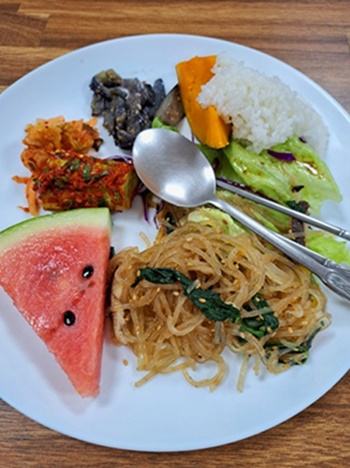
Breakfast at Hwagyesa Temple (Laida Landea Ruiz)
We headed outside after breakfast to see a beaming red sunrise unfold before our eyes. The sun shining through the leaves and the sounds of the flowing stream and birds produced a melody of nature that made me sad to leave the temple that day.
The tour of Hwagyesa began at 7 a.m. We listened to Ven. Cheong-shim's lecture in English on the history of Buddhism and things about the temple.
The participants were most interested in temple food, to which the nun responded, "Korean temples season food with gochujang (red pepper paste) or doenjang (soybean paste) and use indigenous vegetables and roots as main ingredients."
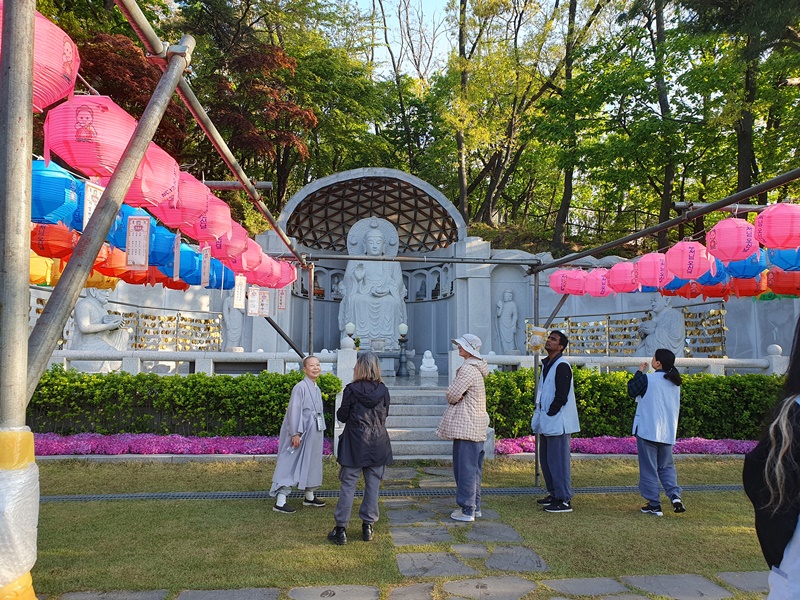
Ven. Cheong-shim gives a lecture on the history of Korean Buddhism during a tour of Hwagyesa Temple. (Cao Thi Ha)
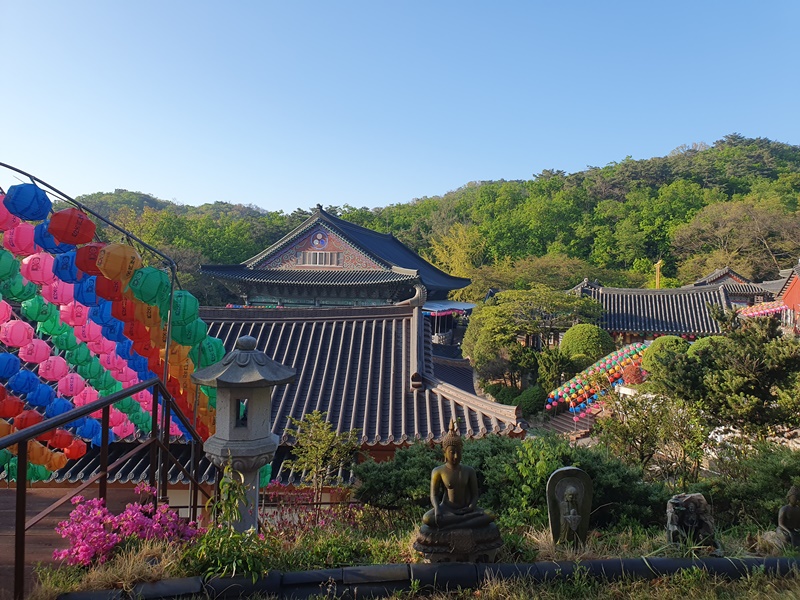
This view of Hwagyesa Temple is from the stone statue of Mireuk, the Korean term for Maitreya. (Cao Thi Ha)
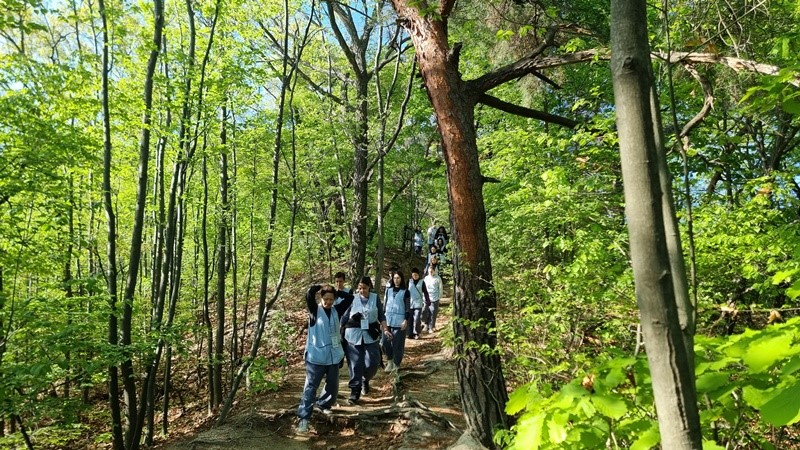
This road of meditation from Hwagyesa Temple leads to Cloud Observatory. (Seo Minji)
After the tour, we walked on a road leading to Bukhansan Dulle-gil White Cloud Observatory while meditating. I thought meditation was done while quietly sitting and organizing your thoughts, so to meditate while walking was interesting.
As I walked slowly and felt clean energy from nature, I felt that all worries I had vanished.
To conclude the templestay, we talked with Ven. Cheong-shim at 9 a.m. over green tea and chocolate seolgi (rice cake).
"Many people visit Hwagyesa Temple to find peace and healing during their stays," the nun said. "Here, they temporarily lay down the chaos of life and their daily burdens to find serenity."
During this templestay, I also met a Korea.net Honorary Reporter and a K-influencer among the participants.
Honorary Reporter Alice Hong, who grew up in Vancouver, Canada, with many trees and wildlife with clean air, said this was her second templestay in Korea. Every visit to a temple made her feel more connected to nature and like she was in Canada, she added.
She called a templestay a good way to learn more about Korean history, recommending meeting people and learning Korean history with them rather than reading books or watching YouTube videos.
Anne-Laure, a K-influencer from France, said she had a very satisfying experience.
She said she travels alone to places as a nomad entrepreneur, and that this was a truly good experience, adding that she met new people and discovered Korean culture.
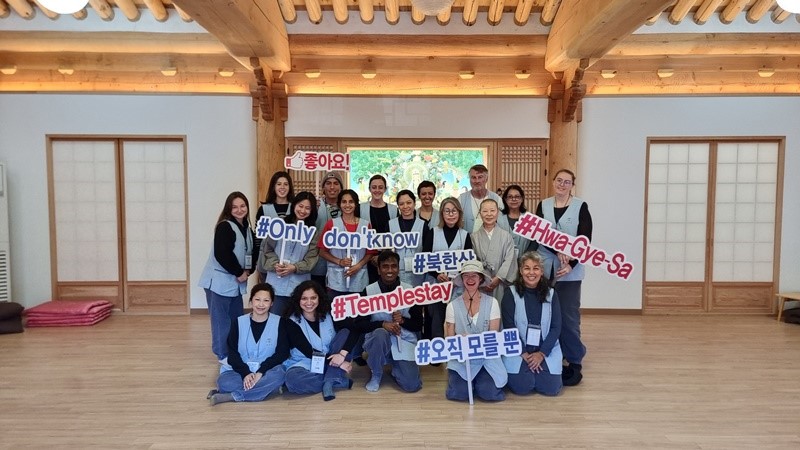
Participants of the templestay at Hwagyesa temple on April 19 take a group photo at the end of the program. (Hwagyesa Temple)
Just 17 hours at the temple was short but this program enabled me to get away from everyday life and temporarily find respite. Returning to the daily grind after the program ended, I felt that I gained the energy to enjoy life a little more thanks to two days of healing time. I recommend a templestay to those weary from everyday life.
| How to participate in a templestay Temple stays are usually held throughout the year. To experience Korean Buddhist culture, click the link below to apply. - https://eng.templestay.com (English, Korean) |